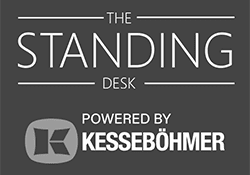Hydraulic, Pneumatic, and Manual Standing Desks –
What’s the Difference?
With all the studies that have been published, you’re probably aware of the health benefits of standing desks, or you may just suspect that standing more at work leads to greater comfort. You may even be looking to increase productivity. There are plenty of reasons to be attracted to standing desks, and the height adjustable kind provides the best of both worlds – sitting and standing.
Why Consider a Pneumatic, Hydraulic, or Manual Standing Desk?
Any desk that needs to adjust between heights requires some mechanism to provide the motion. Electric desks are one option that provides powered lifting assistance. However, many people find the idea of an extra cord in the office unappealing, or may go for a simpler mechanism that promises a smaller environmental impact. In the height adjustable desk market, that just leaves manual, hydraulic, and pneumatic adjustment.

Differences Between Hydraulic vs. Manual vs. Pneumatic Lifting Mechanisms
Although there are other differences, the primary difference between these types of standing desks is the lifting mechanism that adjusts the desk height. Pneumatic and hydraulic standing desks use powered mechanisms to adjust the height of the desk surface, while manual standing desks require more physical effort on behalf of the user.
Manual Standing Desk Operation
A manual standing desk is a type of adjustable desk that does not use any type of powered mechanism to lift the desk surface up and down. Instead, the desk must be manually adjusted by the user, typically using a hand crank or lever to lift the desk surface to the desired height. Manual standing desks require more effort to adjust than pneumatic or hydraulic standing desks, but they may be a more affordable option.
Pneumatic Standing Desk Operation
Pneumatic standing desks use air pressure to raise and lower the desk surface. They are typically adjusted by a lever or button that controls a pneumatic cylinder, a type of mechanical actuator that uses compressed gas to generate motion.

Hydraulic Standing Desk Operation
Hydraulic standing desks use a hydraulic cylinder, a type of mechanical actuator that uses the movement of a fluid (usually oil) to generate motion. They are generally adjusted by a lever or button that controls the flow of fluid to the cylinder.
Benefits of Hydraulic, Pneumatic, and Manual Standing Desks
All three types of standing desks can be used to adjust the height of a desk surface to accommodate people of different heights, or to allow users to switch between sitting and standing positions while working. However, pneumatic and hydraulic standing desks tend to be more convenient to use, as they can be adjusted with the push of a button or lever, while manual standing desks require manual effort to adjust the height.
- Manual Standing Desk: If you don’t plan to adjust your desk height often, you may find a low-cost manual model that suits your needs. A manual desk may require at least 30 seconds of physical effort each time you adjust it throughout the day, which can reduce the habit of using the adjustment. They are also subject to uneven lifting and lowering because the legs may not be calibrated to adjust in sync, and they generally offer a limited adjustment range.
- Hydraulic Standing Desk: A hydraulic standing desk offers powered assistance to lift very heavy loads (compared to other types of desks) with relative speed and smooth movement. However, the hydraulic pump usually requires either electric power or hand cranking, so you have the choice of being dependent on electricity or more manual effort for adjustment. Hydraulic desks can be some of the most expensive on the market.
- Pneumatic Standing Desk: Pneumatic standing desks offer the quickest height adjustments. You’ll find models that excel for smooth, quiet adjustment with a minimum amount of effort on your part, in a variety of sizes depending on your space, your height, and the weight of the items on your desk.
Power-free. Ultra-fast. Built to move.
Our pneumatic desks raise and lower in under 3 seconds—eight times faster than typical electric desks—with no need for power. They’re ideal for dynamic environments or cord-free setups. Add casters to move them effortlessly from one room to another.
-
The Klöud
Our most advanced pneumatic desk, the Klöud features a weight-adjustable mechanism that supports loads from 60 to 150 lbs. A German-engineered counterbalance system ensures smooth, level movement—even with uneven weight distribution. Choose from two surface sizes (48″ and 60″) in five finishes, including real beechwood. -
The Nimbus
The Nimbus shares the Klöud’s steel frame and counterbalance design but with fixed weight assistance (~140 lbs). Ideal for users with a consistent desk setup (e.g., laptop, monitor, keyboard). Offered with a 30″x60″ surface in laminate or real wood finishes. -
The Lüften
Designed for larger workstations, the Lüften features twin columns with a reinforced pneumatic lift. Best for heavier desktop setups up to 50 lbs. Includes a 60” work surface with a floating-style frame. -
The Ändern Pneumatic
A compact, single-column desk that excels in minimalist or small office setups. Perfect for laptops or light-duty monitors. Available in 24″x40″ and 30″x48″ sizes. -
The Möbel Table
Our lightest desk at just 17 lbs, the Möbel is a height-adjustable side table or mobile laptop station. With a 35-lb capacity, it’s ideal for compact spaces, reading nooks, or work-from-anywhere setups. - Shop All Standing Desks
Best Pneumatic Standing Desks
What type of standing desk fits you best? Long term, the ideal standing desk will be the one you use the most. The one that satisfies your needs all day, every day. For many people, that means a long-lasting pneumatic desk. Find the pneumatic desk model that fits your space, your style, and your price range at The Standing Desk.



